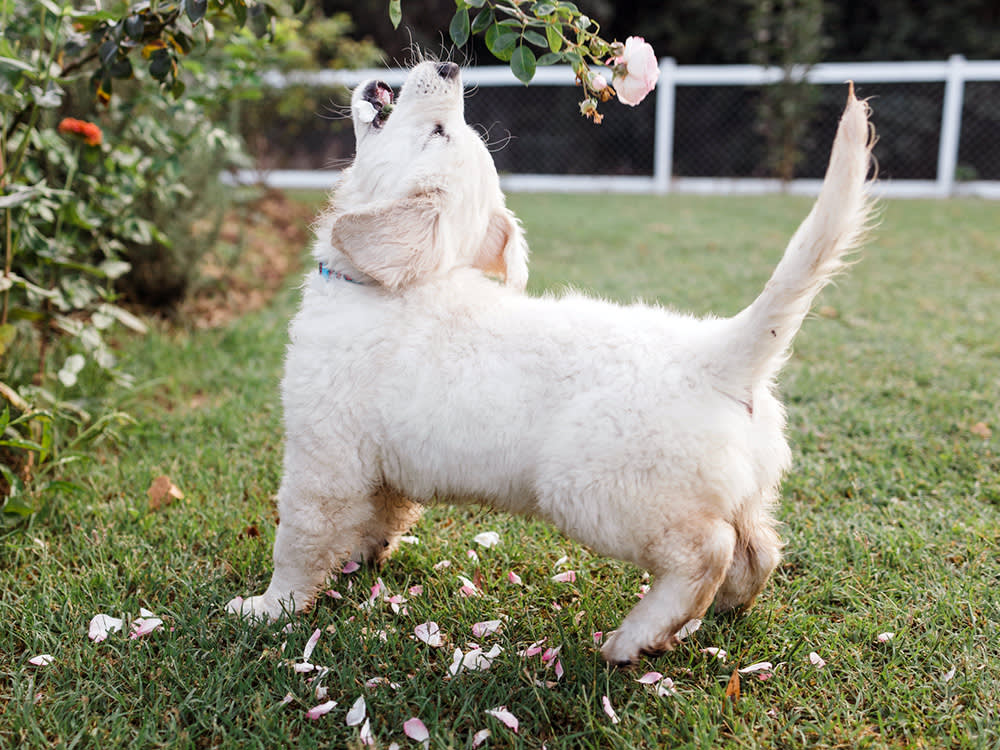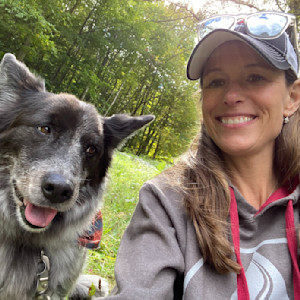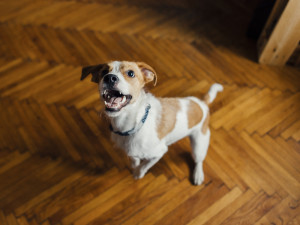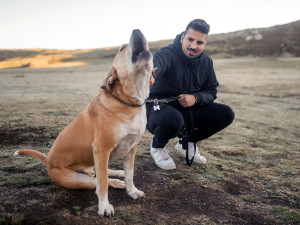How to Train Your Puppy to Stop Barking as Soon as Possible
Follow this guide for a calm and content puppy.

Share Article
In This Article:
Understanding Why Puppies Bark Understanding Triggers for Barking How to Train Your Puppy Not to Bark When Should You Seek Professional Help from a Trainer What Is the Three-Bark Rule?
New puppy parents may find their pup’s first barks delightful, but when that barking becomes incessant and repetitive, you’ll want to learn techniques for restoring calm. Puppies bark for a number of reasons, and with a little troubleshooting and some training techniques, you’ll be able to raise a pup with healthy barking habits. Start now because, as many dog parents will tell you, non-stop barking is one of the hardest behaviors to overcome.
Understanding why puppies bark
“Dogs bark at strangers due to their evolutionary roots,” says Colby Julien, an animal behaviorist and dog trainer at Geo-Sniffingopens in new tab, an outdoor scent pod discovery game for dogs. “Wolves howled to establish territory and avoid conflict.”
It makes sense then if you’re part of the wolf pack, your puppy will bark to defend you. Keep in mind that some breeds bark more than others. Unfortunately, smaller breeds favored for living in close quarters, such as Corgis, Chihuahuas, and terriers, tend to bark the most.

Understanding triggers for barking
Julien says puppies will often bark when they’re bored. “First, check if your dog has enough to do,” she says.
Overstimulation is another reason puppies bark. If puppies get too excited or their environment is over-stimulating, they’ll express their distress — loudly.
“This is why it’s important to teach puppies to relax and not overwork them,” Julien says. “Have your puppy sit next to you while watching TV or working on a computer. Reward them any time they lie down and relax.”
Puppies will also bark to get your attention. Because they’re so cute, their parents will unintentionally reward that barking with a cuddle; therefore, attention barking is usually a pet parent’s fault, Julien says. Eye contact, vocalization, or, worse, yelling, ‘rewards’ the barking with attention.
“Another common mistake is ignoring the barking at first but then giving in out of frustration. This teaches the dog that barking longer works, so they’ll keep at it even more next time. The more you do this, the harder it will be to break it,” Julien says.
Dogs are territorial and have evolved to bark when someone approaches ‘their’ house. Called ‘stranger barking,’ Julien says this behavior is determined by the size of a dog’s ‘bubble,’ or territory. Different dogs have different-sized bubbles. “So this could be someone walking on the sidewalk on their way to school,” she says. “The worst part is this behavior becomes self-reinforcing when barking ‘works’ by making people continue walking away.”
How to train your puppy not to bark
1. Positive reinforcement techniques
Positive reinforcement training can be used if barking or other unwanted behaviors arise at any age. When your pup is barking, take a deep breath and wait for the barking to stop. This may take a while, so be patient. As agonizing as it is to ignore a barking puppy, try to wait for even a short pause in the barking. When your pup exhibits the desired behavior — in this case, they stop barking — immediately reward them with a treat. Eventually, they learn that not barking brings good things.
When they’ve mastered this skill, lengthen the time between when they stop barking and when you give them a treat. As they get better at recognizing the benefits of positive reinforcement, make it fun by varying the amount of time before you give them the treat.
2. Teaching the quiet command
When your pup enters adolescence at around six months, they may start getting sassy and barking more. Like adolescents of another species, they’re testing boundaries. They might begin noticing people walking by the window or even the sound of a neighbor’s footfalls in the apartment next door.
Take advantage of your puppy’s energy and capacity for learning to teach the quiet command (your neighbors will thank you). When your puppy starts barking, say “Quiet!” once in a strong, friendly voice. Then, without repeating the command, wait until they stop barking and immediately shower them with praise and treats.
As with positive reinforcement, once your pup understands the quiet command, gradually lengthen the amount of time from when they stop barking to when you reward them. Initially this should be just a few seconds. Eventually, issue the rewards intermittently but consistently so they understand that they’ll be rewarded every other time or every third time, but not all the time.
3. Using time-outs effectively
Time-outs remove your puppy from what they want most: you. Your timing is essential to effective time-outs. The second your puppy starts barking, remove yourself from the room and close the door, or remove your puppy to a crate or confined space. Be consistent and do this every time they start barking. If not, you’ll confuse your pup. You may need to set aside a day to enact numerous time-outs, but eventually, your puppy will learn that barking leads you to withdraw your attention.
Start by leaving your dog alone for a short time, maybe 30 seconds. Increase the time gradually by increments. Continue using positive reinforcement techniques; as soon as you hear the barking stop, return to your puppy and reward them. If you don’t, they won’t learn the cause and effect of time-outs.
While your puppy is in time-out, stay nearby but out of sight. If the barking continues for several minutes, you can step into sight, which may precipitate a surprised pause in the barking. Immediately reward your puppy by releasing them from the room or the crate. If the barking resumes (and it will at first), repeat the process.
If your puppy starts barking while confined to a crate or a room, try not to let them out until they’ve stopped barking, even for a second, then reward them with a treat or a puzzle toy. The best strategy for keeping your pup quiet during downtime is to tire them out before you put them in the crate.
4. Redirection techniques
Julien says redirecting your puppy while they’re barking is difficult because they’ll most likely ignore what you offer. Managing the environment is key: Block the view with curtains and move the chair or couch they’re climbing on to look out the window. Julien also suggests playing background noise, such as YouTube videos of kids playing, to desensitize your puppy to common sounds in their environment.
What’s more, a tired puppy is a quiet puppy. Exercise is one of the most effective methods for keeping your pup quiet. A tiring walk or long-lasting treats such a Kong stuffed with peanut butter or a puzzle toy will occupy your pup and keep them from barking at times when you need quiet.
When should you seek professional help from a trainer?
Often, when your puppy barks, they’re too excited to pay attention to you. In this case, Julien says to schedule a training session to work on impulse control games so your dog learns the necessary skills to calm down after they get triggered.
A trainer can also help you design a program of games, obedience training, tricks, and agility exercises to keep boredom barking from turning into destructive behavior. “Working dogs like Border Collies will become anxious from lack of stimulation and will find any way to fulfill the need for stimulation. Barking is the least of your problems with a bored dog. Destructive behaviors are sure to follow,” Julien says.
What Is the three-bark rule?
Barking is a communication tool puppies use to convey how they’re feeling and get our attention. We don’t want to communicate to them that what they’re feeling isn’t important, which is where the “three-bark rule” comes in. This dog-training method allows the dog to bark up to three times to alert their parents about someone at the door, for example. After three barks, apply the quiet command or reward them when they stop barking.
References
“How to Stop Territorial Barking | Cummings School of Veterinary Medicine.” Vet.tufts.edu, vet.tufts.edu/news-events/news/how-stop-territorial-barkingopens in new tab.

Catherine Fahy Green
Catherine Fahy Green is a journalist turned copy and content writer. As a pets writer, she focuses on and is fascinated by animal body language because there's so much to learn from and about animals by spending time in their presence and observing their physical cues.
Her work as a PR specialist appears in national trade media as press releases and stories about exciting new products people should try. She lives with her family in Western Massachusetts, where she listens closely to the stories her two dogs, flock of chickens, and four horses tell her. She spends her weekends at horse shows with her daughter.
Related articles
![Dog Lays On The Ground Barking]()
Dog Speak: The Sounds of Dogs
Decoding the many sounds your pup makes.
![Border Collie dog peering behind white fence]()
Why Does My Dog Bark at the Mail Carrier?
How to get your pup and the mail carrier to be friends.
![Wiener dog barking out of window of blue truck]()
Why Do Dogs Bark in the Car?
What to do when your dog barks at everything from other cars to people.
![English bulldog looks through a snow-covered gate]()
Is Your Dog All Bark and No Bite?
A viral video gives new meaning to being on the fence.
![Dog Barking In Nature Next To Its Owner.]()
Getting Ads for Anti-Barking Devices? Here’s Why You Shouldn’t Buy One
Two trainers advocate against using these devices—here’s why.
![Afghan hound dog mid jump in an open grass field]()
Overexcited Dog? How to Calm A Dog Down
If your dog loses their sh*t over anything—from a squirrel to a guest. Here are some tips to curtail that.








